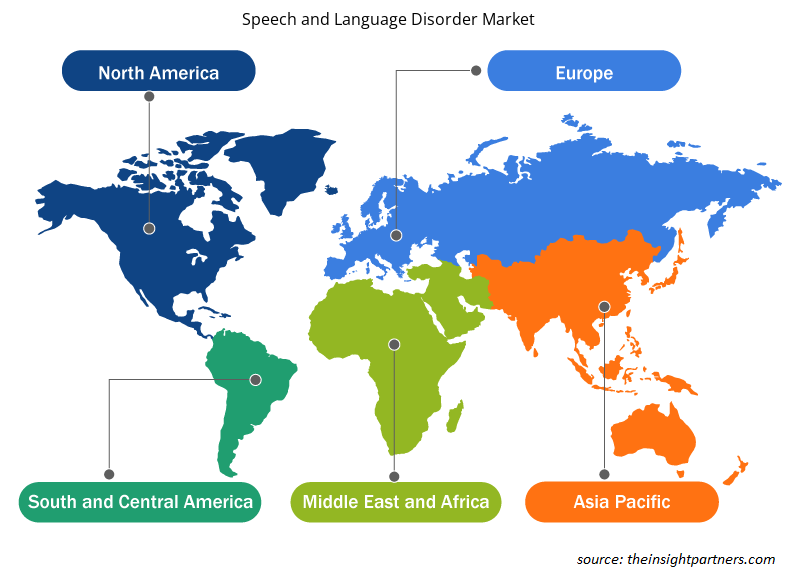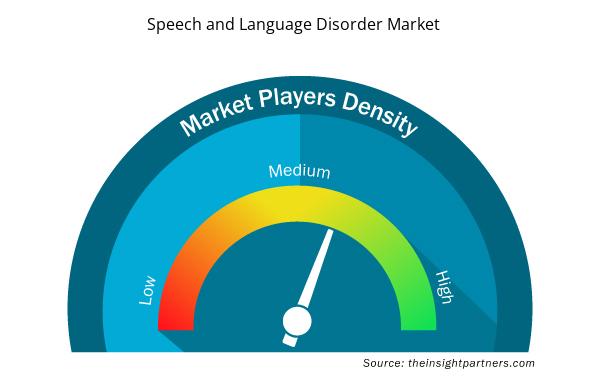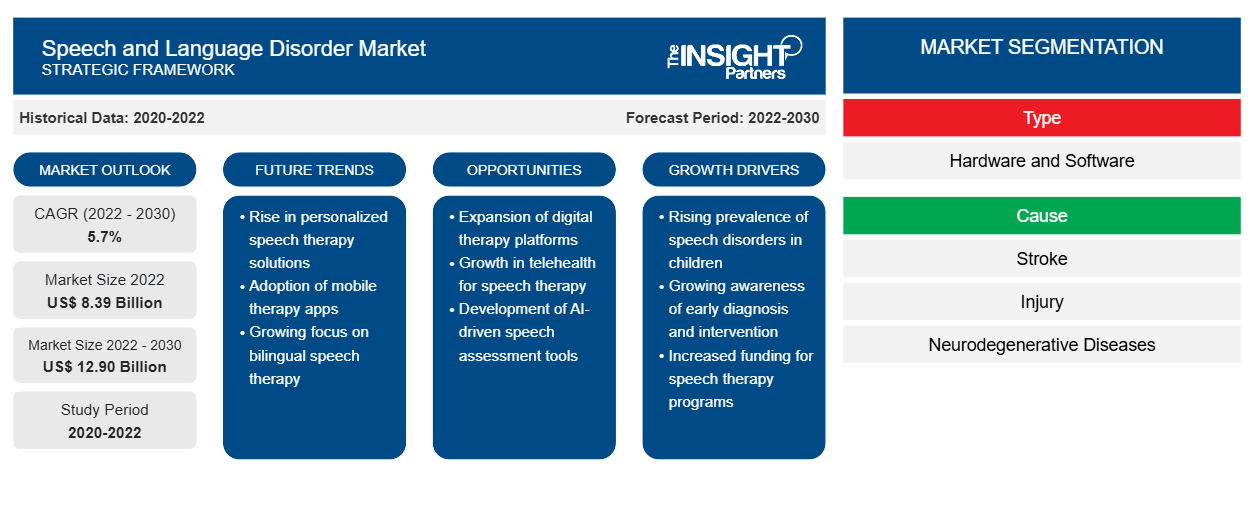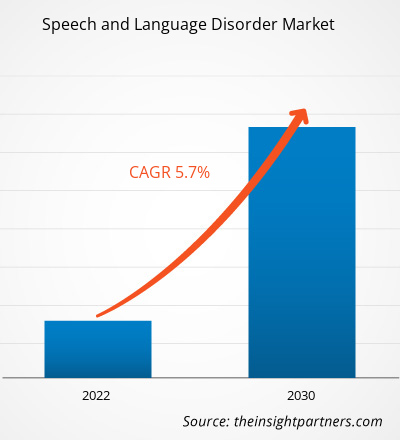[Informe de investigación] Se proyecta que el tamaño del mercado de trastornos del habla y el lenguaje alcance los 12.900 millones de dólares estadounidenses para 2030, desde los 8.390 millones de dólares estadounidenses en 2022. Se espera que registre una CAGR del 5,7 % entre 2022 y 2030.
Perspectivas del mercado y opinión de analistas:
El trastorno del habla es una afección en la que el paciente tiene problemas para formar o crear determinados sonidos del habla necesarios para comunicarse fácilmente con los demás. Mientras que, en el caso de un trastorno del lenguaje, la persona no puede comprender el mensaje o el significado que la otra persona intenta transmitir o tiene dificultades para expresar sus pensamientos de forma adecuada. Los trastornos del habla y del lenguaje pueden producirse a veces debido a trastornos emocionales o del comportamiento. Aunque estos trastornos se están abordando con diversas terapias en las partes desarrolladas del mundo, existe una escasez significativa de profesionales sanitarios en las zonas subdesarrolladas o remotas, lo que está obstaculizando el crecimiento del mercado de los trastornos del habla y del lenguaje.
Factores impulsores del crecimiento y desafíos:
La creciente prevalencia de los trastornos del habla y del lenguaje y el número cada vez mayor de casos de enfermedades neurodegenerativas y accidentes cerebrovasculares impulsan el crecimiento del mercado de los trastornos del habla y del lenguaje. Según los datos publicados por The Stuttering Foundation, más de 80 millones de personas, o el 1% de la población mundial total, tartamudean. Según la misma fuente, alrededor del 5% de todos los niños tartamudean durante aproximadamente 6 meses o más, y alrededor del 1% de estos niños tartamudean más allá del período de tiempo promedio durante un período prolongado.
Además, según el Instituto Nacional de Sordera y Otras Enfermedades de la Comunicación, la prevalencia de trastornos del sonido del habla, como el trastorno de la articulación y el trastorno fonológico, es de alrededor del 8% al 9% en niños pequeños, y alrededor del 3,3% del total de niños estadounidenses de entre 3 y 17 años tienen trastornos del lenguaje. Por lo tanto, la creciente prevalencia de trastornos del habla y del lenguaje, como trastornos de la articulación, trastornos fonológicos y tartamudez, a nivel mundial está impulsando el crecimiento del mercado. Además, se espera que el uso de inteligencia artificial para la terapia del habla y del lenguaje traiga nuevas tendencias de mercado de trastornos del habla y del lenguaje en los próximos años.
Personalice este informe según sus necesidades
Obtendrá personalización en cualquier informe, sin cargo, incluidas partes de este informe o análisis a nivel de país, paquete de datos de Excel, así como también grandes ofertas y descuentos para empresas emergentes y universidades.
- Obtenga las principales tendencias clave del mercado de este informe.Esta muestra GRATUITA incluirá análisis de datos, desde tendencias del mercado hasta estimaciones y pronósticos.
Segmentación y alcance del informe:
El análisis del mercado de los trastornos del habla y del lenguaje se ha llevado a cabo teniendo en cuenta los siguientes segmentos: tipo, causas, tipo de trastorno, grupo de edad, proveedor y geografía. Por tipo, el mercado se bifurca en hardware y software. El segmento de software se segmenta a su vez en basado en la web y basado en aplicaciones. Según la causa, el mercado se segmenta en accidente cerebrovascular, lesión, enfermedades neurodegenerativas y otros. El segmento de enfermedades neurodegenerativas se divide a su vez en esclerosis lateral amiotrófica, enfermedad de Parkinson y enfermedad de Huntington. Según el tipo de trastorno, el mercado se divide en trastornos de la articulación, trastornos fonológicos, trastornos de la voz o trastornos de la resonancia, trastornos del lenguaje y otros.neurodegenerative diseases, and others. The neurodegenerative diseases segment is further divided into amyotrophic lateral sclerosis,
Según la categoría, el mercado se segmenta en adultos y pediatría. El mercado, por proveedor, se segmenta en centros de atención médica, centros de terapia del habla, centros de rehabilitación y otros. Geográficamente, el alcance del informe de mercado de trastornos del habla y del lenguaje se divide principalmente en América del Norte (EE. UU., Canadá y México), Europa (España, Reino Unido, Alemania, Francia, Italia y el resto de Europa), Asia Pacífico (Corea del Sur, China, Japón, India, Australia y el resto de Asia Pacífico), Oriente Medio y África (Sudáfrica, Arabia Saudita, Emiratos Árabes Unidos y el resto de Oriente Medio y África) y América del Sur y Central (Brasil, Argentina y el resto de América del Sur y Central).UAE, and the Rest of Middle East & Africa), and South & Central America (Brazil, Argentina, and the Rest of South & Central America).
Análisis segmental:
El mercado de trastornos del habla y del lenguaje, por tipo, se divide en hardware y software. En 2022, el segmento de software tuvo una mayor participación en el mercado y se espera que registre una CAGR más alta durante 2022-2030.
Según las causas, el mercado se segmenta en accidentes cerebrovasculares, lesiones, enfermedades neurodegenerativas y otros. El segmento de enfermedades neurodegenerativas se divide a su vez en enfermedad de Parkinson, ELA y enfermedad de Huntington. En 2022, el segmento de accidentes cerebrovasculares tuvo la mayor participación de mercado en trastornos del habla y el lenguaje. Se espera que el segmento de enfermedades neurodegenerativas registre la CAGR más alta durante 2022-2030.
Según el tipo de trastorno, el mercado se divide en trastornos de la articulación, trastornos fonológicos, trastornos de la voz o trastornos de la resonancia, trastornos del lenguaje y otros. En 2022, el segmento de trastornos de la articulación tuvo la mayor participación de mercado en el mercado de trastornos del habla y el lenguaje. Sin embargo, se espera que el mismo segmento registre la CAGR más alta durante 2022-2030.
Según la categoría, el mercado de trastornos del habla y del lenguaje se divide en adultos y pediatría. En 2022, el segmento pediátrico tuvo una mayor participación en el mercado y se espera que registre una CAGR más alta durante 2022-2030.
El mercado, por proveedor, está segmentado en centros de atención médica, centros de terapia del habla, centros de rehabilitación y otros. En 2022, el segmento de centros de atención médica tuvo la mayor participación de mercado en trastornos del habla y el lenguaje y se prevé que registre la CAGR más alta durante 2022-2030.
Análisis regional:
Geográficamente, el mercado se divide en América del Norte, Europa, Asia Pacífico, Oriente Medio y África, y América del Sur y Central. América del Norte es el mayor contribuyente al mercado mundial de trastornos del habla y del lenguaje. Se prevé que Asia Pacífico muestre la CAGR más alta en el mercado durante 2022-2030. América del Norte tuvo la mayor participación del mercado mundial en 2022 debido al aumento de los casos de trastornos neurodegenerativos, el aumento del uso de terapias del habla basadas en aplicaciones, el aumento de la prevalencia de trastornos del habla como la disfluencia y la presencia de actores clave del mercado. En América del Norte, Estados Unidos tuvo la mayor participación del mercado en 2022.
Perspectivas regionales del mercado de trastornos del habla y del lenguaje
Los analistas de Insight Partners explicaron en detalle las tendencias y los factores regionales que influyen en el mercado de trastornos del habla y del lenguaje durante el período de pronóstico. Esta sección también analiza los segmentos y la geografía del mercado de trastornos del habla y del lenguaje en América del Norte, Europa, Asia Pacífico, Oriente Medio y África, y América del Sur y Central.

- Obtenga datos regionales específicos para el mercado de trastornos del habla y del lenguaje
Alcance del informe de mercado sobre trastornos del habla y del lenguaje
| Atributo del informe | Detalles |
|---|---|
| Tamaño del mercado en 2022 | US$ 8.39 mil millones |
| Tamaño del mercado en 2030 | US$ 12.90 mil millones |
| CAGR global (2022-2030) | 5,7% |
| Datos históricos | 2020-2022 |
| Período de pronóstico | 2022-2030 |
| Segmentos cubiertos | Por tipo
|
| Regiones y países cubiertos | América del norte
|
| Líderes del mercado y perfiles de empresas clave |
|
Densidad de actores del mercado de trastornos del habla y del lenguaje: comprensión de su impacto en la dinámica empresarial
El mercado de los trastornos del habla y del lenguaje está creciendo rápidamente, impulsado por la creciente demanda de los usuarios finales debido a factores como la evolución de las preferencias de los consumidores, los avances tecnológicos y una mayor conciencia de los beneficios del producto. A medida que aumenta la demanda, las empresas amplían sus ofertas, innovan para satisfacer las necesidades de los consumidores y aprovechan las tendencias emergentes, lo que impulsa aún más el crecimiento del mercado.
La densidad de actores del mercado se refiere a la distribución de las empresas o firmas que operan dentro de un mercado o industria en particular. Indica cuántos competidores (actores del mercado) están presentes en un espacio de mercado determinado en relación con su tamaño o valor total de mercado.
Las principales empresas que operan en el mercado de trastornos del habla y del lenguaje son:
- Soluciones terapéuticas Tactus Ltd.
- Centro de habla virtual
- El grupo Meco
- MyTalkTools Móvil
- iComunicarse
Descargo de responsabilidad : Las empresas enumeradas anteriormente no están clasificadas en ningún orden particular.

- Obtenga una descripción general de los principales actores clave del mercado de trastornos del habla y del lenguaje
Desarrollos industriales y oportunidades futuras:
El pronóstico del mercado de trastornos del habla y del lenguaje se estima en función de diversos hallazgos de investigación primaria y secundaria, como publicaciones de empresas clave, datos de asociaciones y bases de datos. Las estrategias de los actores clave que operan en el mercado de trastornos del habla y del lenguaje se enumeran a continuación:
- En agosto de 2021, CHOC lanzó un estudio piloto sobre la aplicación de terapia del habla que se desarrolló con la ayuda de estudiantes universitarios de último año de la Facultad de Información y Ciencias de la Computación (ICS) de la UC Irvine. Amplify es una aplicación diseñada para hacer que la terapia del habla sea más conveniente, atractiva e interactiva tanto para los médicos como para los pacientes mediante el uso de un juego de aventuras. Esta aplicación alberga una biblioteca completa de ejercicios de aventuras audibles interactivos para mejorar las habilidades del habla que están integrados en la historia.
Panorama competitivo y empresas clave:
Tactus Therapy Solutions Ltd, Virtual Speech Center, The Meco Group, MyTalkTools Mobile, iCommunicate, iConverse, Skylineinnovation, Speak Up, Proloquo2Go y Talkitt se encuentran entre los actores destacados que aparecen en el informe de mercado sobre trastornos del habla y el lenguaje. Además, se han estudiado y analizado varios otros actores durante el estudio para obtener una visión holística del mercado y su ecosistema. Estas empresas se centran en las expansiones geográficas y los lanzamientos de nuevos productos para satisfacer la creciente demanda de los consumidores de todo el mundo y aumentar su gama de productos en carteras especializadas. Su presencia global les permite atender a una gran base de clientes, lo que facilita posteriormente la expansión del mercado.
- Análisis histórico (2 años), año base, pronóstico (7 años) con CAGR
- Análisis PEST y FODA
- Tamaño del mercado Valor/volumen: global, regional, nacional
- Industria y panorama competitivo
- Conjunto de datos de Excel


- Single Pair Ethernet Market
- Influenza Vaccines Market
- Europe Industrial Chillers Market
- Pharmacovigilance and Drug Safety Software Market
- Queue Management System Market
- Mice Model Market
- Electronic Signature Software Market
- Rugged Servers Market
- Water Pipeline Leak Detection System Market
- Nuclear Decommissioning Services Market

Report Coverage
Revenue forecast, Company Analysis, Industry landscape, Growth factors, and Trends

Segment Covered
This text is related
to segments covered.

Regional Scope
North America, Europe, Asia Pacific, Middle East & Africa, South & Central America

Country Scope
This text is related
to country scope.
Preguntas frecuentes
Growing prevalence of speech and language disorders and increasing cases of neurodegenerative diseases and stroke propel the market growth. However, the unavailability of speech therapy in underdeveloped or remote areas and the lack of healthcare professionals are hampering the growth of the market. The use of artificial intelligence for speech and language therapy is expected to bring new speech and language disorder market trends in the coming years.
Speech disorder is a condition in which the patient has a problem in forming or creating particular speech sounds required to communicate with others easily. Whereas, in language disorder, the person cannot understand the message or meaning the other person is trying to convey or has difficulty in expressing their thought properly. Speech and language disorders may sometimes occur due to behavioral or emotional disorders. Although these disorders are being addressed with various therapies in developed parts of the world, there is a significant shortage of healthcare professionals in underdeveloped or remote areas, which is hampering the speech and language disorder market growth.
Based on geography, the speech and language disorder market is segmented into North America (the US, Canada, and Mexico), Europe (the UK, Germany, France, Italy, Spain, and the Rest of Europe), Asia Pacific (China, Japan, India, South Korea, Australia, and the Rest of Asia Pacific), the Middle East & Africa (the UAE, Saudi Arabia, South Africa, and Rest of the Middle East & Africa), and South & Central America (Brazil, Argentina, and the Rest of South & Central America). North America is the largest contributor to the growth of the global speech and language disorder market. Asia Pacific is expected to register the highest CAGR in the speech and language disorder market during 2022–2030.
The speech and language disorder market majorly consists of the players such Tactus Therapy Solutions Ltd, Virtual Speech Center, The Meco Group, MyTalkTools Mobile, iCommunicate, iConverse, Skylineinnovation, Speak Up, Proloquo2Go, and Talkitt.
The speech and language disorder market, by type, is bifurcated into hardware and software. The software segment is further divided into web-based and app-based. In 2022, the software segment held a larger share of the market and is expected to record a higher CAGR during 2022–2030.
Based on cause, the market is segmented into stroke, injury, neurodegenerative diseases, and others. The neurodegenerative diseases segment is further divided into Parkinson's disease, amyotrophic lateral sclerosis, and Huntington's disease. In 2022, the stroke segment held the largest speech and language disorder market share. However, the neurodegenerative diseases segment is expected to record the highest CAGR during 2022–2030.
Based on disorder type, the market is divided into articulation disorders, phonological disorders, voice disorders or resonance disorders, language disorders, and others. In 2022, the articulation disorders segment held the largest share of the speech and language disorder market and is expected to record the highest CAGR during 2022–2030.
Based on category, the speech and language disorder market is bifurcated into adults and pediatric. In 2022, the pediatric segment held a larger share of the market and is expected to record a higher CAGR during 2022–2030.
The market, by provider, is segmented into healthcare facilities, speech therapy centers, rehabilitation centers, and others. In 2022, the healthcare facilities segment held the largest share of the speech market and is expected to record the highest CAGR during 2022–2030.
Trends and growth analysis reports related to Technology, Media and Telecommunications : READ MORE..
The List of Companies - Speech and Language Disorder Market
- Tactus Therapy Solutions Ltd
- Virtual Speech Center
- The Meco Group
- MyTalkTools Mobile
- iCommunicate
- iConverse
- Skylineinnovation
- Speak Up
- Proloquo2Go
- Talkitt
The Insight Partners performs research in 4 major stages: Data Collection & Secondary Research, Primary Research, Data Analysis and Data Triangulation & Final Review.
- Data Collection and Secondary Research:
As a market research and consulting firm operating from a decade, we have published and advised several client across the globe. First step for any study will start with an assessment of currently available data and insights from existing reports. Further, historical and current market information is collected from Investor Presentations, Annual Reports, SEC Filings, etc., and other information related to company’s performance and market positioning are gathered from Paid Databases (Factiva, Hoovers, and Reuters) and various other publications available in public domain.
Several associations trade associates, technical forums, institutes, societies and organization are accessed to gain technical as well as market related insights through their publications such as research papers, blogs and press releases related to the studies are referred to get cues about the market. Further, white papers, journals, magazines, and other news articles published in last 3 years are scrutinized and analyzed to understand the current market trends.
- Primary Research:
The primarily interview analysis comprise of data obtained from industry participants interview and answers to survey questions gathered by in-house primary team.
For primary research, interviews are conducted with industry experts/CEOs/Marketing Managers/VPs/Subject Matter Experts from both demand and supply side to get a 360-degree view of the market. The primary team conducts several interviews based on the complexity of the markets to understand the various market trends and dynamics which makes research more credible and precise.
A typical research interview fulfils the following functions:
- Provides first-hand information on the market size, market trends, growth trends, competitive landscape, and outlook
- Validates and strengthens in-house secondary research findings
- Develops the analysis team’s expertise and market understanding
Primary research involves email interactions and telephone interviews for each market, category, segment, and sub-segment across geographies. The participants who typically take part in such a process include, but are not limited to:
- Industry participants: VPs, business development managers, market intelligence managers and national sales managers
- Outside experts: Valuation experts, research analysts and key opinion leaders specializing in the electronics and semiconductor industry.
Below is the breakup of our primary respondents by company, designation, and region:

Once we receive the confirmation from primary research sources or primary respondents, we finalize the base year market estimation and forecast the data as per the macroeconomic and microeconomic factors assessed during data collection.
- Data Analysis:
Once data is validated through both secondary as well as primary respondents, we finalize the market estimations by hypothesis formulation and factor analysis at regional and country level.
- Macro-Economic Factor Analysis:
We analyse macroeconomic indicators such the gross domestic product (GDP), increase in the demand for goods and services across industries, technological advancement, regional economic growth, governmental policies, the influence of COVID-19, PEST analysis, and other aspects. This analysis aids in setting benchmarks for various nations/regions and approximating market splits. Additionally, the general trend of the aforementioned components aid in determining the market's development possibilities.
- Country Level Data:
Various factors that are especially aligned to the country are taken into account to determine the market size for a certain area and country, including the presence of vendors, such as headquarters and offices, the country's GDP, demand patterns, and industry growth. To comprehend the market dynamics for the nation, a number of growth variables, inhibitors, application areas, and current market trends are researched. The aforementioned elements aid in determining the country's overall market's growth potential.
- Company Profile:
The “Table of Contents” is formulated by listing and analyzing more than 25 - 30 companies operating in the market ecosystem across geographies. However, we profile only 10 companies as a standard practice in our syndicate reports. These 10 companies comprise leading, emerging, and regional players. Nonetheless, our analysis is not restricted to the 10 listed companies, we also analyze other companies present in the market to develop a holistic view and understand the prevailing trends. The “Company Profiles” section in the report covers key facts, business description, products & services, financial information, SWOT analysis, and key developments. The financial information presented is extracted from the annual reports and official documents of the publicly listed companies. Upon collecting the information for the sections of respective companies, we verify them via various primary sources and then compile the data in respective company profiles. The company level information helps us in deriving the base number as well as in forecasting the market size.
- Developing Base Number:
Aggregation of sales statistics (2020-2022) and macro-economic factor, and other secondary and primary research insights are utilized to arrive at base number and related market shares for 2022. The data gaps are identified in this step and relevant market data is analyzed, collected from paid primary interviews or databases. On finalizing the base year market size, forecasts are developed on the basis of macro-economic, industry and market growth factors and company level analysis.
- Data Triangulation and Final Review:
The market findings and base year market size calculations are validated from supply as well as demand side. Demand side validations are based on macro-economic factor analysis and benchmarks for respective regions and countries. In case of supply side validations, revenues of major companies are estimated (in case not available) based on industry benchmark, approximate number of employees, product portfolio, and primary interviews revenues are gathered. Further revenue from target product/service segment is assessed to avoid overshooting of market statistics. In case of heavy deviations between supply and demand side values, all thes steps are repeated to achieve synchronization.
We follow an iterative model, wherein we share our research findings with Subject Matter Experts (SME’s) and Key Opinion Leaders (KOLs) until consensus view of the market is not formulated – this model negates any drastic deviation in the opinions of experts. Only validated and universally acceptable research findings are quoted in our reports.
We have important check points that we use to validate our research findings – which we call – data triangulation, where we validate the information, we generate from secondary sources with primary interviews and then we re-validate with our internal data bases and Subject matter experts. This comprehensive model enables us to deliver high quality, reliable data in shortest possible time.


 Obtenga una muestra gratuita de este informe
Obtenga una muestra gratuita de este informe